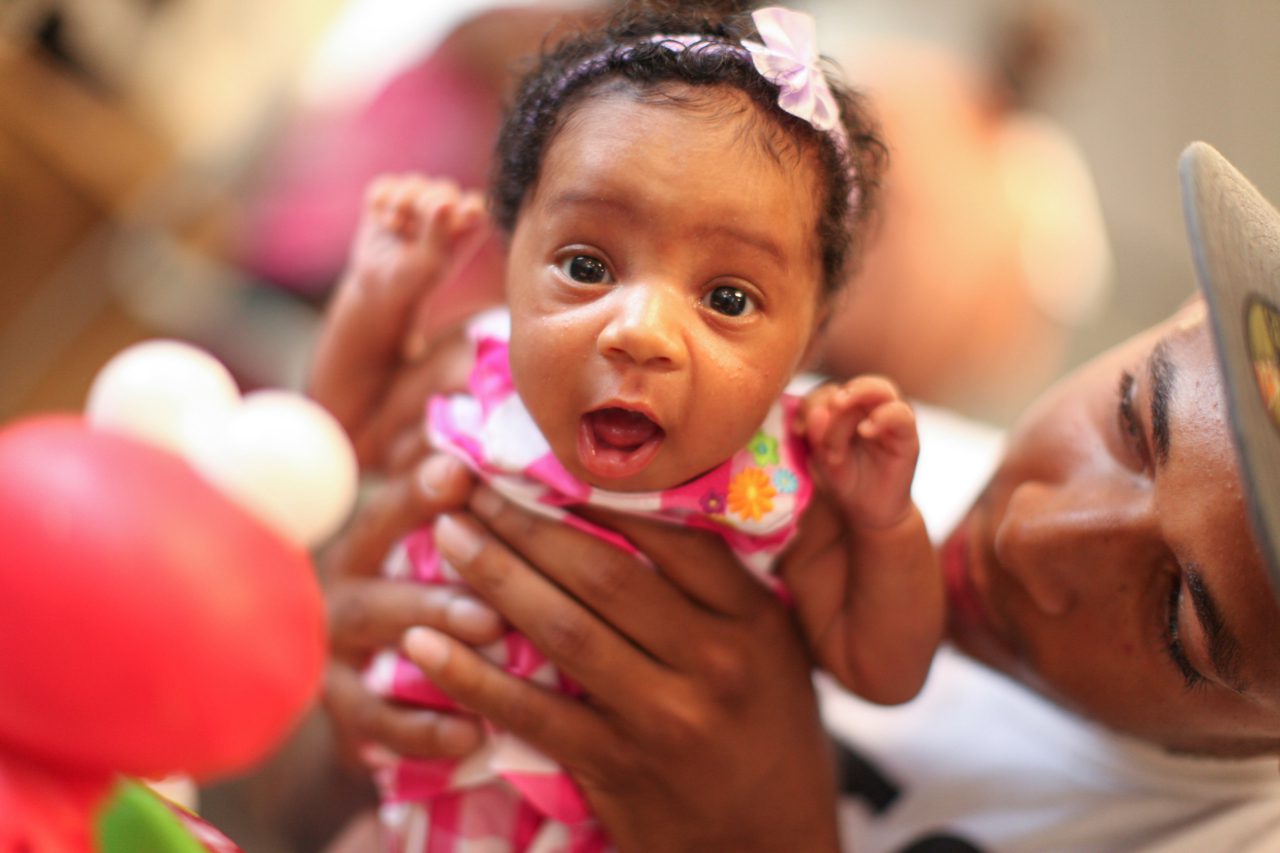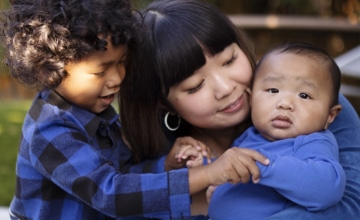Ross A. Thompson, University of California
Andrew N. Meltzoff, University of Washington
Walter S. Gilliam, Yale University

Editor’s Note: This article is adapted from a presentation for ZERO TO THREE’s Scientific Meeting held on April 27, 2021. The topic for this year’s meeting was Race, Equity, Bias, and Early Childhood. We invited three ZERO TO THREE board members who have studied the impact of racial bias and inequity on young children to share their work. In this article, Dr. Andrew Meltzoff describes his research concerning the ways that young children pick up bias from everyday experience, and Dr. Walter Gilliam discusses racial bias exhibited by early childhood educators. Dr. Brenda Jones Harden, who discussed maternal experiences of racial discrimination and its impact on mothers’ functioning and parenting of their young children, expands on her research in the article, “Racial Discrimination and Parenting: Implications for Intervening With African American Young Children and Families” (Scott et al., this issue, p. 18). Dr. Ross Thompson, board member and past president of ZERO TO THREE, introduced the session.
The Development of Social Categories and Preferences by Ross A. Thompson
Humans are a social species. They are an uber-social species. Humans are a species that has never lived alone as individuals, and consequently, a lot of human behavior and psychology is oriented toward living together. One aspect of the psychology of human group living is making and using social categories to help navigate the social world. Adults use social categories because it enables them to reason about the likely behavior, thoughts, and reactions of people according to their group membership. Adults can make predictions about other people’s preferences and dispositions based on their group membership, and because these predictions usually (albeit not always) turn out to be correct, they make social interaction much easier. And it appears, in recent work with very young children, that this tendency to create and use social categories is baked into who humans are. This tendency certainly emerges early. Even in the first year, infants begin differentiating among people according to social categories. What kind of social categories do they create and use? There is evidence that they begin differentiating among people according to race and gender. And even more remarkably, infants differentiate among people according to their spoken language and even their accent. Furthermore, and consistent with how adults use social categories, children in the first year of life expect people who share these characteristics to be alike in other ways, such as the food they like and who they interact with, and they expect them to be similar in other ways, too (Liberman et al., 2017).
It is not just social categories by which infants begin mapping the social world—they also begin developing social preferences. And the research is clear that infants prefer people who have the same characteristics that they do. When it comes to people who have characteristics that are like theirs, the research shows that infants are preferring to look at them, preferring to imitate them, and preferring to turn to them to learn new information, and in other activities they show these preferences also.

Even in the first year, infants begin differentiating among people according to social categories. Photo: Jacob Lund/shutterstock
Familiarity seems to be a major reason for these social category preferences. That is, one reason that infants prefer people whose characteristics are like their own is that those characteristics are probably also shared by others in the baby’s social world, and thus these characteristics are familiar. As evidence for this, infants prefer to interact with speakers of the same language that others around them speak, and even show a preference for individuals who speak that language with the same accent. Preferences for people based on familiarity can work in complex ways, however. For example, preference for same-race faces in infants is diminished when they live in multicultural environments and are therefore exposed to people of different races and ethnicities. And to be clear, infants prefer to look at same-race faces and speakers who share the child’s language, but they also prefer generally to look at female faces, regardless of whether infants are male or female. And this is where the influence of familiarity again is apparent, because in many cases it is women who are the ones who are providing their primary care. Female faces are thus more familiar, and preferred (Rhodes & Baron, 2019).
As this developing process of social differentiation continues, there is evidence that between 3 and 6 years old (and there’s evidence that perhaps this occurs even earlier), children begin showing an in-group preference as they increasingly perceive themselves not just as individuals, but as group members. They prefer in-group over out-group members. They furthermore expect in-group members to follow shared rules and to help and share with each other. And this applies to themselves young children are more likely to interact with and help members of their group compared to other children who are not members of their group—even when group membership has been arbitrarily assigned (Dunham, 2018)!
Young children can even acquire negative beliefs about the out-group—even when group membership is made in a random manner. In one experiment, a group of children were brought into a lab and half of them were given t-shirts of one color and half of them t-shirts of another color. Immediately, based simply on the t-shirts they had been given, children began differentiating among those who were part of their group and those who were not part of their group (Patterson & Bigler, 2006)
Why Are Social Categories so Important to Young Children?
It really raises the important question for scientists and practitioners about why in the world does social categorization develop so early and so strongly? There are several explanations that have been offered in the research literature (Rhodes & Baron, 2019).
Essentialism
One explanation is that young children seem to view categories simply as a natural and important characteristic of the world in which they live. They early learn that different animal species can be classified categorically (e.g., dogs and birds), and different objects in the natural world can be classified categorically (e.g., rocks and plants), so perhaps categorical differences are also true in similar ways between the social categories of the human world. Conceptually, furthermore, they seem to regard category membership as essential. Essentialism is the belief that things have a set of essential characteristics that make them what they are. And these characteristics are ingrained, they are unchanging, they are established at birth, and they really are important in helping to distinguish one thing from another. Young children readily appreciate that if a baby cow was adopted and raised by a family of pigs, the cow would not become a pig because it was essentially a cow (Gelman & Wellman, 1991). And so, they think, the same must be true of differences between people of different races, and genders, and other characteristics. These differences are important, unchanging, and define who they are.
In much the same way that young children begin to develop categories for different animal species, therefore, they naturally extend that way of thinking about categories as essential to the social categories that are part of their social lives. Essentialism seems to be an important driver behind young children’s thinking about the importance of the social categories they encounter. In the clever words of the title of a research study in this area: “Boys will be boys, and cows will be cows” (Taylor, 2009).
Social Obligation
Another explanation of the early development of social categorization and its influence is that young children believe that social categories confer social obligation. Social categories are an important part of defining “What is expected of me?” “What am I supposed to do in relation to other people?” Membership in a social category implies responsibility to other members of that group. And children, early in the preschool years, seem to pick this obligation up and respond accordingly, in part because they are quickly beginning to perceive themselves as members of groups, not just as individuals. And because so much of the social world that they inhabit also thinks of them as members of social groups—being a member of a family, of a classroom, of a racial group, of a team—young children quickly understand the importance of social group membership and the social obligations it confers (Rhodes, 2012).
Adult Use of Generic Language
A third reason that young children socially categorize so early and so strongly is because of how adults talk about different social groups. In particular, when adults use generic language in referring to social categories, they encourage children to think about these categories in essentialist terms. For example, saying something like, “Boys like to play with trucks,” rather than saying, “This boy likes to play with trucks” confers something importantly different about boys and girls, even if the speaker’s intention was simply to point out something interesting about the behavior of a single boy. The use of generic language in the first case helps to convey the idea that this is an inherent quality in boys that children should pay attention and respond to (Rhodes et al., 2018).
“Like Me” Orientation
A fourth and final reason that early social categorization is so influential is that young children are also learning about themselves. Young children are thus motivated to discover the social categories to which they belong and the characteristics that are associated with their own group. The process of social categorization helps them learn about themselves and about the attributes that are associated with the categories to which they belong. By being with other boys, boys learn how to be a boy; by being with other children who speak the same language, children learn what other characteristics come with speaking that language. Andy Meltzoff has described this as a “Like me” orientation (Meltzoff, 2007). It is an important part of developing social understanding.
Categorization vs. Discrimination
It is important to recognize that in addition to these ways that children develop social categories and social preferences, it is also apparent that young children are also very interested in differences in race, in language, in cultural and family practices, in ethnicity, and special needs, and in other characteristics of people. Part of children’s mapping of the social world is not just categorizing those who are similar and different but also becoming interested and immersed in the human diversity that surrounds them. In light of this, it is worth remembering that social categorization, even social preferences, are not the same thing as social discrimination and prejudice.
Infants prefer to interact with speakers of the same language that others around them speak, and even show a preference for individuals who speak that language with the same accent.
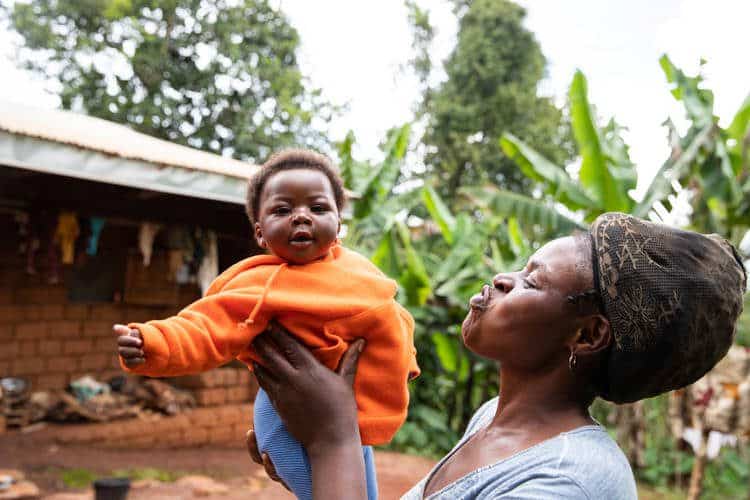
Infants prefer to interact with speakers of the same language that others around them speak, and even show a preference for individuals who speak that language with the same accent. Photo: matteoguedia/shutterstock
In the discussions that follow, the authors will explore how social values begin to infuse the categories that children create and use from their social experience. How do young children pick up racial bias from everyday experience? How are they affected by others’ perceptions of them? What are the implications of how children come to understand the social world for the work that researchers and practitioners do?
Author Bio
Ross A. Thompson, PhD, is Distinguished Professor of Psychology at the University of California, Davis, and immediate past president of ZERO TO THREE’s Board of Directors. Dr. Thompson’s expertise focuses on early personality and socio-emotional development in the context of close relationships. His work in the cross-disciplinary field of developmental relational science pursues dual tracks. First, his research explores the influence of relational processes on emotional growth, conscience development, emotion regulation, and self-understanding in young children. Second, he has worked on the applications of developmental relational science to public policy problems concerning children and families, such as early childhood mental health, the constituents of school readiness, divorce and child custody concerns, child maltreatment prevention, and research ethics. He was on the National Research Council and Institute of Medicine committee that produced the landmark report From Neurons to Neighborhoods: The Science of Early Childhood Development (2000), and on a second committee that produced Transforming the Workforce for Children Birth Through Age 8: A Unifying Foundation (2015). He is the recipient of the Urie Bronfenbrenner Award for Lifetime Contribution to Developmental Psychology in the Service of Science and Society from the American Psychological Association, 2018, UC Davis Distinguished Scholarly Public Service Award, 2011, and the Ann L. Brown Award for Excellence in Developmental Research, 2007.
References
Dunham, Y. (2018). Mere membership. Trends in Cognitive Sciences, 22, 780–793.
Gelman, S. A., & Wellman, H. M. (1991). Insides and essences: Early understandings of the non-obvious. Cognition, 38, 213–244.
Liberman, Z., Woodward, A. L., & Kinzler, K. D. (2017). The origins of social categorization. Trends in Cognitive Sciences, 21, 556–568.
Meltzoff, A. N. (2007). The “like me” framework for recognizing and becoming an intentional agent. Acta Psychologica, 124, 26–43.
Patterson, M. M., & Bigler, R. S. (2006). Preschool children’s attention to environmental messages about groups: Social categorization and the origins of intergroup bias. Child Development, 77, 847–860.
Rhodes, M. (2012). How two intuitive theories shape the development of social categorization. Child Development Perspectives, 7, 12–16.
Rhodes, M., & Baron, A. (2019). The development of social categorization. Annual Review of Developmental Psychology, 1, 359–386.
Rhodes, M., Leslie, S. J., Bianchi, L., & Chalik, L. (2018). The role of generic language in the early development of social categorization. Child Development, 89, 148–155.
Taylor, M. G. (2009). Boys will be boys; cows will be cows: Children’s essentialist reasoning about gender categories and animal species. Child Development, 80, 461–481.
The Development of Prejudice by Andrew N. Meltzoff
Infants are not born with prejudices. Yet, the budding prejudices of kindergarten children are painfully obvious. Where do such prejudices come from? New research in our lab suggests that observational social learning is one mechanism by which adults inadvertently sow the seeds of prejudice in the minds of children. Young children, even infants, watch adults in their culture and are drawn to imitate them. In everyday life, toddlers learn to poke computer keys and use channel changers in part through imitation. Toddlers learn from watching adults even if the adults don’t encourage them to do so, and indeed even if adults explicitly try to tell them not to reproduce the behavior. Imitation is a form of “implicit” learning. Parents are not using Skinnerian reinforcement to shape up children; rather, children learn from studying the behavior of others and are motivated to be and act like adults. My research establishes that imitation is ubiquitous, powerful, long-lasting, and starts early—a key mechanism for learning in the birth to 3 years age period (Meltzoff & Marshall, 2018; Meltzoff & Williamson, 2013).
Crucially, young children go beyond duplicating specific behaviors. They also pick up beliefs, attitudes, and values that are expressed by family members and the culture at large. They progress from newborns, imitating specific behaviors, to toddlers and preschoolers who imitate the attitudes, values, and customs that they see exhibited by trusted others in their cultural milieu (Barragan & Meltzoff, 2021; Meltzoff & Marshall, 2018).
Parents often ask, “Is prejudice caught or taught?” Research indicates that early biases can be caught through the unintentional leakage of adult behavior in front of young children. Children are watching. They learn whether adults want them to or not. One of the things they learn from watching adults is prejudices.
Observational Social Learning
My colleagues and I published two articles demonstrating how observational social learning may serve as a mechanism for the intergenerational transmission of racial biases (Skinner et al., 2017, 2020). Experiments described in both articles involved showing preschoolers a short vignette of social interactions between adults.
Negative Signals
To illustrate the procedure of the first study, consider a 4 1⁄2-year-old girl in our lab. She watches a video showing an adult seated between two other people wearing different colored t-shirts (see Figure 1). First, the adult in the center turns to face the person on the left of the screen and responds in a very positive way saying, “Hi” using her best motherese voice and positive affect (e.g., smiling, warm tone of voice, leaning in, eagerness to interact).
Figure 1. Preschool Children Watch a Video Vignette of a Biased Social Interaction
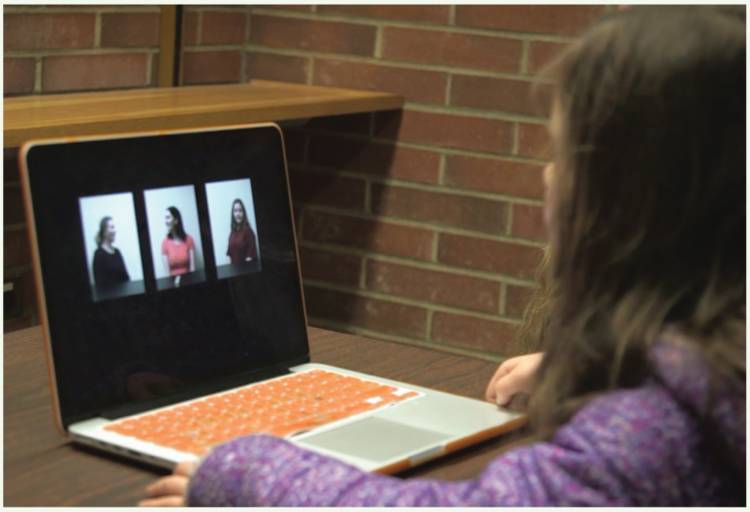
In a video vignette, the center adult turns to interact with a person on one side. Children watch attentively as the adult interacts with each person in turn. The adult acts negatively toward one person and not to the other. (From a movie by Mind in the Making about the experiment by Skinner, Meltzoff, & Olson, 2017. Psychological Science, 28(2), 216-224). Photo: courtesy of Andrew Meltzoff
Then she turns to the person on the right-hand side and repeats “Hi” but she acts in a very cold and rejecting way (e.g., scowling, cold tone of voice, leaning away, reluctance to interact). The variation in tone and affect communicates a negativity about that person.
When we then ask the child, “Can you point to who you like best?” children systematically point to the person that had received the positive signal. Significantly more often than not, the children indicated that they liked one of these two strangers more than the other.
Prosocial behavior was measured by giving the child a stuffed toy, and asking who they wanted to share it with. Children shunned the person who had received the negative signals—the one who seemed to be “rejected”—and children wanted to give the toy to the person who was the recipient of the positive signals.
We also went beyond liking the person and willingness to share resources with them. We measured imitation by having the two people demonstrate novel behaviors and verbally label the objects with different words. The children more often imitated the behaviors and language of the recipient of the positive signal. In sum, children preferentially liked, shared with, and learned from one person and minimized/ downgraded the other, the person who had received the negative signals. We further discovered that children acted in these biased ways toward a brand-new person who wore the same color t-shirt as the recipient of negativity and was described as that person’s “friend.”
Generalization of Social Biases
This work suggests that children can learn biases toward individuals based on how adults interact with others. Citizens, parents, and policymakers are even more concerned about bias directed toward whole groups of people who look a certain way, so in a second experiment we tested generalization to large social groups. We showed preschoolers two maps, each filled with images of 16 individuals who were wearing the same color t-shirts used in the previous videos. One “country” on the map was filled with people in the light reddish shirts, and the other “country” on the map was filled with people in the dark colored shirt (see Figure 2). The experiment followed the same general procedure as before inasmuch as children watched a vignette of adult interactions.
Figure 2. Maps of Social Groups
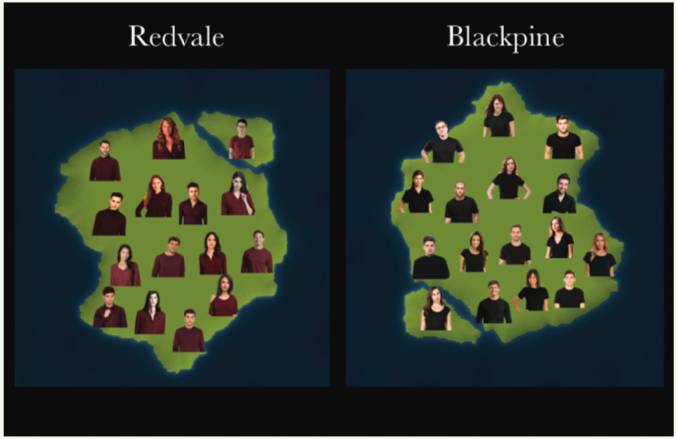
Preschoolers were shown two social groups that were distinguished by color. (From Skinner, Olson, & Meltzoff, 2020, Journal of Personality and Social Psychology, 119(4), 824–838.) Photo: courtesy of Andrew Meltzoff
We also added a measure of children’s desire to interact with this group of people who “looked like” the person who was the target of bias. For this measure we said that we were going to play a game and needed a third person to help us play. We asked the children who they wanted us to bring into room for this activity. If children had seen a red-shirted person be the recipient of the negative signals, they would significantly more often than chance point to the map of the people from Redvale and convey that they did not want that kind of person to join.
This result shows that children generalize far beyond the specific person who was “dissed” on the video and that their evaluations extend to a class of others who simply looked like that person—others of the same color (colored t-shirt in this case), even though none of those specific individuals had been seen before. This is a heartbreaking result for 4 1⁄2-year-olds, but they generalized in this way.
How Social Bias Spreads
These experiments reveal three important things about how adults inadvertently spread biases to children.
First, it’s rapid. Preschoolers learn rapidly to adopt the biases that adults direct toward others, and then they generalize to groups of others who look similar.
Second, children absorb these biases from mere observation. None of the adults did anything to the child directly. The adults didn’t interact with the child. The child was simply a third-party observer of the adults. Children seem to care deeply about the social interactions they see, and this observation alters their own subsequent behavior (for a related study with babies, see Repacholi et al., 2016).
Third, this research can help explain the “transmissibility” of prejudice, and how it may be inadvertently transferred from parents to children. Young children don’t have to interact with someone to form an opinion about that person. They don’t need direct experience. They only need to observe how an adult treats that person to catch the adult’s attitude toward that person. For example, picture a mother who goes to the supermarket with a preschooler and there is somebody in line behind them who appears to be of a race, ethnicity, or dressed in a way that rouses the parent’s prejudices. The mother may speak crossly to that person or reach down to clutch her child’s hand and pull the child toward her. Children learn from this. If the parent goes to a new environment and does the same thing, the child notices these reactions and tries to understand the pattern. I like to say that children are “social pattern detectors.” Although the mother isn’t verbally and explicitly instructing her child to adopt a prejudice, she is demonstrating a pattern. Children watch, learn, remember, and generalize. Our experiments suggest that children won’t just shun the specific individual who the mother reacted to negatively, but a whole class of others who look like that person.
Open Questions
There are a variety of questions to explore:
- First, what is the duration of the effects we demonstrated? How long do these induced biases last? These experiments tested children immediately after showing them videos. What would happen if we tested children a day later, or a week later? How durable are the effects?
- Second, the video showed adults interacting. As children grow older, they are very interested in what their peers do. What if the biases had been modeled by peers instead of adults?
- Third, what’s the role of emotional relationships? What if this prejudice is demonstrated by the child’s own parent or caregiver rather than a stranger? The effects might be magnified if the children repeatedly observe a trusted person demonstrating the prejudice.
- Fourth, what can parents and professionals do? Bias reduction programs have been designed for adults. Are there mitigation or prevention strategies that can be used with children while they are young and neurally plastic?
Learn More
I-LABS Research Briefs on Diversity, Equity, and Inclusion
(https://modules.ilabs.uw.edu/equity-briefs)
I-LABS Video Learning Modules
(https://modules.ilabs.uw.edu/learning-modules)
Next Steps
Even before there are well-designed, evidence-based intervention strategies backed by randomized controlled trials, there may be some immediate actions to take. Early childhood professionals can create messages for parents that “children are watching” and are catching biases that adults unconsciously communicate. Children are social pattern detectors. The good news is that young children learn positive values they see adults demonstrate, such as helping and prosocial behavior (Barragan & Meltzoff, 2021; Thompson, 2015), but they also learn negative values and prejudices that adults exhibit (see the studies mentioned previously). These results give new and poignant meaning to the phrase that “parents are the children’s first and best teachers.”
It is possible to move beyond parents and speculate about early child childhood education providers. Walter Gilliam and colleagues have shown that Black children, especially Black boys, are expelled from preschool at a disproportionate rate (Gilliam et al., 2016). His research also indicated that preschool teachers disproportionately look toward Black boys when they think someone in the class is going to misbehave but don’t yet know who will do so. Gilliam infers that teachers’ implicit bias is driving their looking behavior and disciplinary choices. These findings, together with our research, lead one to ask: What do the other preschoolers learn when teachers look toward Black boys when there is impending trouble or when teachers disproportionately expel Black boys? I have already established that observational social learning is a powerful mechanism. We thus have a perfect storm for brewing prejudice in the minds of young children. The teacher’s own implicit biases are manifest in her behavioral patterns. These biases are picked up by the children in the class who may then imitate or conform to her implicit social worldview, causing changes in the children’s beliefs, attitudes, and behaviors toward Black children they encounter.
What can we do to change the situation? Some helpful resources about prejudice and racism are located on the website of the University of Washington’s Institute for Learning & Brain Sciences (I-LABS), including briefs and video modules about diversity, equity, and the acquisition of prejudice in young children:
- Before elementary school, children demonstrate biases based on social groups such as race, nationality, gender, and more. One way children acquire these biases is by observing the behaviors of adults around them. Children can learn social biases from watching everyday behavior as adults interact with others (Skinner et al., 2020).
- Young children from minority groups, such as Native Americans, often know that they are targets of prejudice, which influences their attitudes toward themselves, school, and other institutions of the dominant culture (Cvencek et al., 2018).
- Adults can combat childhood prejudice by facilitating meaningful contact and connections with people who are different from them. Intentional education and intergroup contact reduce children’s budding prejudices (for programs that work, see Skinner & Meltzoff, 2019). Moreover, intentional parent–child conversations about race and equity can be helpful, as opposed to adopting a color-mute stance and pretending to children that prejudice doesn’t exist (see the Learn More box in this article referring to I-LABS online learning modules #13 and #14).
- Race, gender, and especially their intersectionality are important components of young children’s identity (Rogers & Meltzoff, 2017). Research on identity development in multiracial children is especially urgent in light of demographic changes in the USA.
- Children are deeply influenced by gender stereotypes held by their parents and others, such as “girls don’t do math.” These pernicious stereotypes are internalized and influence young children’s interests, sense of belonging, and academic development (Cvencek et al., 2011; Master & Meltzoff, 2020).
- A more complete understanding of the development of prejudice will require longitudinal studies measuring children’s attitudes toward in-groups and out-groups, as well as children’s own self-esteem. How children feel about themselves is intertwined with how they feel about “others like me”–in other words, their in-groups (Cvencek et al., 2016).
- The science of learning draws links between brain science, diversity, and education. Studies of childhood neuroplasticity from birth to 3 years old point to a new synthesis between biology and culture (Meltzoff et al., 2009). Studies reveal that healthy social–cognitive development thrives on diversity, which is changing both developmental theory and education practice (Lee et al., 2020).
Author Bio
Andrew N. Meltzoff, PhD, holds the Job and Gertrud Tamaki Endowed Chair at the University of Washington, where he is the co-director of the Institute for Learning & Brain Sciences (I-LABS) and a professor of psychology. Dr. Meltzoff is a board member of ZERO TO THREE. Dr. Meltzoff is a pioneer in the study of infant learning and social understanding. His discoveries about infant imitation have shaped the understanding of learning mechanisms in the first 3 years of life. In addition, Dr. Meltzoff has examined infants’ earliest notions of self, infant gaze following, and the origins of theory of mind. Meltzoff and colleagues are now using infant brain measures (EEG, MEG) to uncover neurobiological mechanisms underlying social and cognitive development. He has established an outreach division at I-LABS that is dedicated to disseminating research findings and combining research and practice to improve the lives of infants and caretakers. Dr. Meltzoff has published more than 250 scientific papers and co-authored three books including The Scientist in the Crib: What Early Learning Tells Us About the Mind. He is the recipient of numerous prizes including the William James Fellow Award, the highest award given by the Association for Psychological Science for a lifetime of significant intellectual contributions (2020), and the American Psychological Association’s G. Stanley Hall Award for distinguished contributions to developmental psychology (2020). Dr. Meltzoff has presented his research to the U.S. Congress, the Organisation for Economic Co-operation and Development, UNESCO, at the Vatican, and other venues. He received his bachelor’s degree from Harvard University and doctorate from Oxford University.
References
Barragan, R. C., & Meltzoff, A. N. (2021). Human infants can override possessive tendencies to share valued items with others. Scientific Reports, 11, 9635.
Cvencek, D., Fryberg, S. A., Covarrubias, R., & Meltzoff, A. N. (2018). Self-concepts, self-esteem, and academic achievement of minority and majority North American elementary school children. Child Development, 89(4), 1099–1109.
Cvencek, D., Greenwald, A. G., & Meltzoff, A. N. (2016). Implicit measures for pre-school children confirm self-esteem’s role in maintaining a balanced identity. Journal of Experimental Social Psychology, 62, 50–57.
Cvencek, D., Meltzoff, A. N., & Greenwald, A. G. (2011). Math–gender stereotypes in elementary school children. Child Development, 82(3), 766–779.
Gilliam, W. S., Maupin, A. N., Reyes, C. R., Accavitti, C., & Shic, S. F. (2016). Do early educators’ implicit biases regarding sex and race relate to behavior expectations and recommendations of preschool expulsions and suspensions? Yale Child Study Center.
Lee, C. D., Meltzoff, A. N., & Kuhl, P. K. (2020). The braid of human learning and development: Neurophysiological processes and participation in cultural practices. In N. S. Nasir, C. D. Lee, R. Pea, & M. McKinney de Royston (Eds.), Handbook of the cultural foundations of learning (pp. 24–43). Routledge.
Master, A. H., & Meltzoff, A. N. (2020). Cultural stereotypes and sense of belonging contribute to gender gaps in STEM. International Journal of Gender, Science and Technology, 12(1), 152–198.
Meltzoff, A. N., Kuhl, P. K., Movellan, J., & Sejnowski, T. J. (2009). Foundations for a new science of learning. Science, 325(5938), 284–288.
Meltzoff, A. N., & Marshall, P. J. (2018). Human infant imitation as a social survival circuit. Current Opinion in Behavioral Sciences, 24, 130–136.
Meltzoff, A. N., & Williamson, R. A. (2013). Imitation: Social, cognitive, and theoretical perspectives. In P. D. Zelazo (Ed.). Oxford handbook of developmental psychology (pp. 651–682). Oxford University Press.
Repacholi, B. M., Meltzoff, A. N., Toub, T. S., & Ruba, A. L. (2016). Infants’ generalizations about other people’s emotions: Foundations for trait-like attributions. Developmental Psychology, 52(3), 364–378.
Rogers, L. O., & Meltzoff, A. N. (2017). Is gender more important and meaningful than race? An analysis of racial and gender identity among Black, White, and mixed-race children. Cultural Diversity and Ethnic Minority Psychology, 23(3), 323–334.
Skinner, A. L., & Meltzoff, A. N. (2019). Childhood experiences and intergroup biases among children. Social Issues and Policy Review, 13(1), 211–240.
Skinner, A. L., Meltzoff, A. N., & Olson, K. R. (2017). “Catching” social bias: Exposure to biased nonverbal signals creates social bias in preschool children. Psychological Science, 28(2), 216–224.
Skinner, A. L., Olson, K. R., & Meltzoff, A. N. (2020). Acquiring group bias: Observing other people’s nonverbal signals can create social group biases. Journal of Personality and Social Psychology, 119(4), 824–838.
Thompson, R. A. (2015). The development of virtue: A perspective from developmental psychology. In N. E. Snow (Ed.), Cultivating virtue: Perspectives from philosophy, theology, and psychology (pp. 279–306). Oxford University Press.
Implicit Bias in Early Childhood Education by Walter S. Gilliam
After nearly 20 years studying children who are expelled and excluded from early childhood education programs, I’ve realized that the real problem isn’t preschool expulsion itself. The real problem is the constellation of root issues that lead to this worst-case outcome.
In 2002, when my colleagues and I started collecting data on the rates at which children were being expelled from prekindergarten programs that are mostly coordinated through the public schools, we found that 3- and 4-year-olds were expelled at a rate more than 3 times that of grades kindergarten through 12 combined (Gilliam, 2005). And in community-based child care programs outside of the schools, they may be expelled at a rate about 13 times higher than kindergarten through 12 combined (Gilliam & Shahar, 2006). But the problem of expulsion included children even younger than preschoolers. A smaller prior study, 3 years before our study came out, found that 42% of infant–toddler early childhood education programs in Illinois had reported expelling at least one infant or toddler in the previous year (Cutler & Gilkerson, 2002). So this problem isn’t just about 3- and 4-year-olds, it’s also about babies that are getting kicked out of early childhood programs.
There are a lot of ways one can look at this. It is fascinating to note that the pre-K expulsion rate, even more so than the K through 12 expulsion rate, in terms of number of children expelled per thousand, is very similar to the U.S. incarceration rates among adults (Walmsley, 2013). (See Figure 1.) Perhaps incarceration can be thought of the closest thing to expulsion for adults. Although the rate of incarceration is about the same as the rate of preschool expulsion, what may be more telling is that the degree of gender and racial disparity is virtually identical between preschool expulsion and adult incarceration. The exact same children who are expelled at greater levels in preschool become the exact same adults who are incarcerated at greater levels as adults. Of course, this similarity in disparities does not necessarily prove that there is a preschool-to-prison pipeline, but if there is one, it’s amazing how consistent the diameter of the pipe is all the way from the preschool years to the adult years.
Figure 1. Preschool to Prison Pipeline
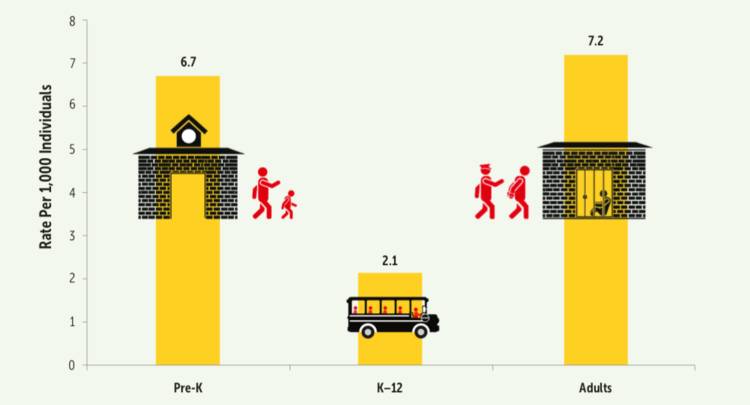
Gilliam, 2005; Walmsley, 2013.
Other researchers have replicated this finding. The U.S. Department of Education’s Office for Civil Rights (2014, 2016) documented that, indeed, Black children, boys, and especially Black boys, are far more likely to be expelled or suspended. Also, researchers analyzing data from the National Survey of Children’s Health (2016-present) have replicated these disparities and have demonstrated that every early adverse childhood experience that they considered shows an increased odds ratio for preschool expulsion and suspension (Zeng et al., 2019). (See Table 1.)
Table 1. ACEs & Preschool Expulsion/Suspension
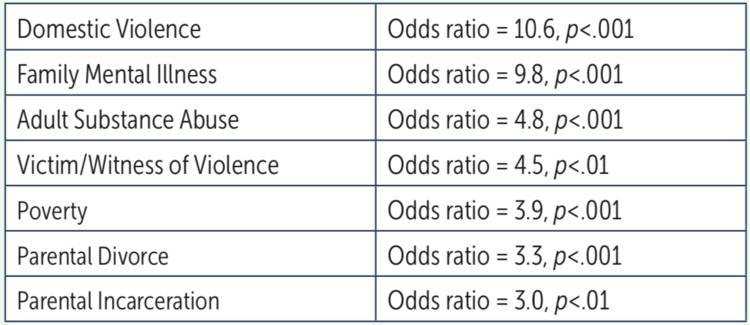
Zeng et al., 2019.
For example, a side effect of adult substance abuse may be preschool expulsion for a child living in the home. Therefore, any adverse experience a child is experiencing also increases the likelihood that they are going to get one more adverse experience: getting kicked out of a preschool program. All of this together raised questions for my colleagues and me, “Why is it that Black children, and Black boys especially, are more likely to be expelled from programs like preschools and other early childhood education programs? Is it possible that implicit biases may play a role in higher expulsion rates for certain children?”
What Is Implicit Bias?
Implicit biases are hard to measure. They are like the wind in that you can’t really see them, but you can see their effects. So researchers try to measure implicit biases by measuring the effects of them. If they are successful at that, then they may get a sense of what the implicit bias is. One way to describe implicit bias may be through a well-known riddle.
The Riddle of Implicit Bias
Two men, a father and a son, are driving down the road. Unfortunately, they are in a terrible accident. The father dies immediately, and the son is in critical condition. The son is taken to the nearby hospital. At the hospital, the nurses are scrubbing in and preparing the patient for surgery. They have called in the top surgeon at the hospital to perform this life-saving surgery. The surgeon arrives, scrubs in, enters the operating room, and looks at the patient. Then the surgeon looks up at the nurses and says, “I can’t do this surgery. That’s my son.”
Listeners might ask: “How can that patient be the son of the surgeon, if the father had died in the car accident?” Some may come to the conclusion that perhaps the patient has a biological father and a stepfather, or maybe he has two dads because he has two gay dads. A listener once suggested to me that perhaps the patient is Catholic, and the man in the car was his priest. Of course, all of those solutions are possible, but perhaps the easiest solution would be that the surgeon is his mother!
The possibility that the top surgeon is a woman may be a hard conclusion for many people to imagine. And that’s how biases work. Biases are based on representations that an individual has in their mind. That can be a representation of what a surgeon looks like, or what a lawyer looks like, but also what the “teacher’s pet” looks like, and what the “troublemaker” in the class looks like, what the easygoing child looks like, and what the more difficult child to care for looks like. It is very easy to rely on those images, these representations, and make decisions based on these categories that are already developed in one’s mind. The reason that this riddle works is because it taps into an implicit bias unfortunately held by too many people, that a top surgeon would be a man and not a woman.
Implicit Bias in Preschool
Knowing the importance of these implicit biases, my colleagues and I conducted a study to understand a little more about how biases might factor into the disparities in race and gender of children being expelled from preschool programs.
Where Do Teachers Look for Challenging Behavior?
In one experiment (Gilliam et al., 2016) my colleagues and I had a group of preschool teachers from around the country sit individually in front of a computer screen while wearing headphones. (See Figure 2.) They watched a 6-minute video. The video showed four children sitting around a table, and it was recorded from a variety of different angles so that we could change the children’s position on the screen.
Figure 2. A Re-Enactment of the “Eye-Tracking” Bias Study
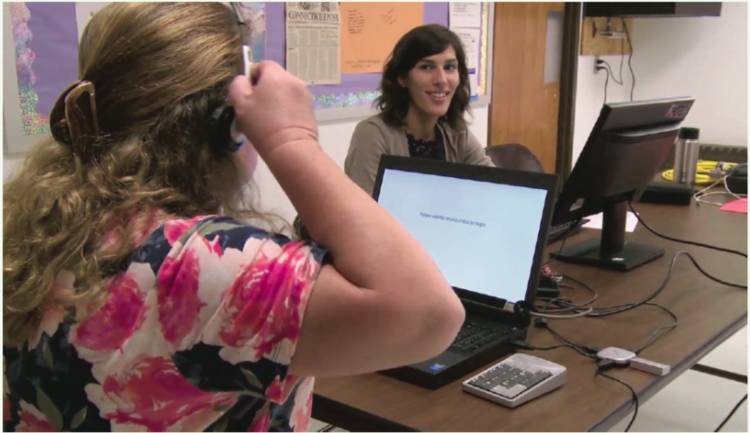
Preschool teachers from around the country sit individually in front of a computer screen while wearing headphones to watch a 6-minute video and determine which children they feel are most likely to exhibit challenging behaviors. Photo: Andrew Meltzoff
The computer they were using also had an eye tracker. This device, placed on the laptop at the bottom of the screen, measured exactly where the teacher was looking on that screen, down to a thousandth of a second.
The instructions given to the teachers were something like this: “This is a study to see how quickly teachers can find evidence of challenging behaviors. Anytime that you see a child do something that could turn into a challenging behavior, I want you to hit this button.” The key component of the experiment was something the teachers were not told: None of these children are going to misbehave. They were all going to behave appropriately because all of these children were essentially child actors for this study; a Black boy, a Black girl, a White boy, and a White girl. Their job for the day, basically, was to sit at the table and play with Play-Doh.
The questions my colleagues and I were interested in were the following: When teachers believe that a child is going to misbehave, where do they look? Where do they look first? Where do they look the longest? Where do they keep going back to see what they may have missed? This first goal was to discover whether it’s possible that teachers see more challenging behaviors in certain children, because that’s where they are looking for challenging behaviors. Teachers do not so easily see challenging behaviors in places where they are not looking for them. And perhaps they are not looking for challenging behaviors in particular children because they don’t expect to see those behaviors there. The eye tracker places a yellow dot on a second computer screen that is showing the same video that the teacher is watching, and that computer records all the teacher’s eye movements. The yellow dot shows exactly where the teacher is looking at any particular moment. My colleagues and I can analyze the eye tracker video frame by frame to identify where each child was and then calculate the amount of time each teacher was looking at each child. (See Figure 3.)
Figure 3. A Still Frame From the “Eye-Tracking” Video, With Individual Children Outlined to Calculate Results
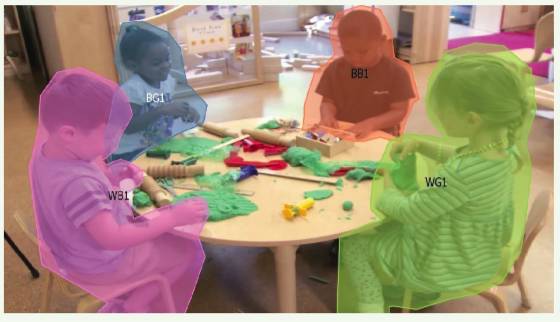
Photo: Andrew Meltzoff
When the video ends, the screen goes blank. The teacher is shown a screen containing a photo of each child with a letter used to identify that child, and then is asked to remember the letter of the child they feel they had to watch the most. The eye tracker is still tracking their eye movements while they answer this question. The screen goes blank one final time, and then the teacher is asked to enter the letter of the child that they might have had to watch the most.
The experiment examined three different things:
- During the 6-minute video, where did the teachers’ biases take their eyes?
- After watching the video, were they aware of watching a particular child more than the others?
- When asked to identify the child they watched most, were they willing to admit it?
Both White and Black teachers spent the most time watching the Black boy, waiting for bad behavior that never happened. In another part of the experiment, teachers read a one-paragraph biographical description of a hypothetical child with a racially stereotypical name. The description was intended to help explain a child’s poor behavior in the classroom and included some problems or stressors in the child’s home life.
My research team wanted to know whether this information would make the teachers feel more empathetic toward the child. It did, but only if the teacher and the child were of the same race (Turner, 2016).
Teachers’ Implicit Biases
The first disturbing finding from this experiment is that when teachers were led to believe that a child was going to misbehave, they looked more at Black children, especially the Black boy. And that implicit bias was true not only of the White teachers but also for teachers across all racial groups, revealing a racial lens by which they—and presumably most adults—view children and children’s behaviors. The second experiment revealed that there is also a racial lens in terms of in-group versus out-group on how they view trauma information. When a teacher hears about a traumatic experience that a family or child is going through, those facts may sound different and have a different impact on the teacher’s thoughts about the child, depending on whether the teacher is same race of the child versus not.
Social Justice and Civil Right Are Matters of Access
Social justice and civil rights are often considered matters of access. That could mean access to a seat on a bus or a seat at a deli counter. It could mean access to voting, access to higher education, or access to education for much younger children. But access is not just about getting in the front door. It is also about not getting pushed out the back door, too. And it is also about the experiences of children and families when they are in early childhood education programs.
I once spoke about expulsion and racial biases at a conference in Las Vegas, Nevada. A while after my presentation, during lunch, the emcee came onto the stage with a young girl, who appeared to be middle-school aged. The emcee asked the girl, “What brought you to this conference?”
The girl answered, “I came here with my mother.”
The emcee then asked, “And what do you remember from the conference?”
The girl said, “Well, I remember when that professor guy talked about how teachers look at kids like me.” And when she said that, I felt afraid and concerned. I was worried that maybe I had said something that might hurt her, or might negatively impact the way she views teachers and schools.
Then the emcee asked her, “And how did that make you feel?”
And the girl said something I will never forget. She said, “Well, me and my friends, we already knew it. We just didn’t think you-all did.”
Her response reveals the effect of implicit bias. Our children see it. They see it, they pick it up, they learn it, it affects them as the recipients, and it affects them as bystanders, too, just as Andy Meltzoff (this article) explained though his work with his colleagues (Skinner et al., 2020). And that’s why this topic is so very important. We adults need to develop effective ways to manage better our biases, especially within the context of our work with young children. If not, we risk continuing harm to children, both directly to the children who experience our biases and indirectly through the children who will learn their biases by observing ours.
Learn More
The Edward Zigler Center in Child Development and Social Policy
(www.ziglercenter.yale.edu)
Author Bio
Walter S. Gilliam, PhD, is the Elizabeth Mears and House Jameson Professor of Child Psychiatry and Psychology at the Yale University Child Study Center, and director of the Edward Zigler Center in Child Development and Social Policy. Dr. Gilliam is chair of the Committee on the Board of ZERO TO THREE. Dr. Gilliam has conducted extensive research involving early childhood education and intervention policy analysis, ways to improve the quality and mental health of prekindergarten and child care services, early childhood mental health consultation, early childhood expulsions and suspensions, the impact of early childhood education on school readiness, implicit bias in early childhood settings, and the health and well-being of early childhood professionals. In 2008, Dr. Gilliam was the co-recipient of the Grawemeyer Award in Education for the most influential work in the field of education and was awarded the Priscilla Canny Research Award from Connecticut Voices for Children for the researcher who has most benefited children through state government. He has authored or coauthored numerous publications on young child development and early education and intervention, including the books A Vision for Universal Preschool Education (2006) and The Pre-K Debates: Current Controversies and Issues (2011). His research and work are frequently covered by international and national media.
References
Cutler, A., & Gilkerson, L. (2002). Unmet Needs Project: A research, coalition building, and policy initiative on the unmet needs of infants, toddlers, and families. University of Illinois.
Gilliam, W. S. (2005). Prekindergarteners left behind: Expulsion rates in state prekindergarten systems. Yale University Child Study Center. link
Gilliam, W. S., & Shahar, G. (2006). Preschool and child care expulsion and suspension: Rates and predictors in one state. Infants & Young Children, 19(3), 228–245
Gilliam, W. S., Maupin, A. N., Reyes, C. R., Accavitti, C., & Shic, S. (2016). Do early educators’ implicit biases regarding sex and race relate to behavior expectations and recommendations of preschool expulsions and suspensions? Yale Child Study Center.
National Survey of Children’s Health. (2016-present). link
Skinner, A. L., Olson, K. R., & Meltzoff, A. N. (2020). Acquiring group bias: Observing other people’s nonverbal signals can create social group biases. Journal of Personality and Social Psychology, 119(4), 824–838.
Turner, C. (2016). Implicit bias in preschools. link
U. S. Department of Education, Office for Civil Rights (2014). Civil rights data collection: Data snapshot: Early childhood education. link
U.S. Department of Education, Office for Civil Rights. (2016). 2013-2014 civil rights data collection: A first look: Key data highlights on equity and opportunity gaps in our nation’s public schools. link
Walmsley, R. (2013). World prison population list (10th ed.). International Centre for Prison Studies.
Zeng, S., Corr, C. P., O’Grady, C., & Guan, Y. (2019). Adverse childhood experiences and preschool suspension expulsion: A population study. Child Abuse & Neglect, 97, 104149.
Suggested Citation
Thompson, R. A., Meltzoff, A. N., & Gilliam, W. S. (2021). Race, equity, bias, and early childhood: Examining the research. ZERO TO THREE Journal, 42(1), 5–16.

